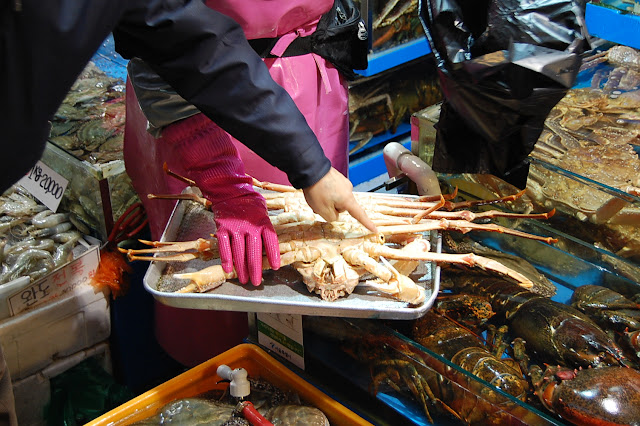Koreans love their meat. Ask any vegetarian who’s visited South
Korea and they’ll tell you how difficult it is to order meat-free meals here. Nearly everything has either pork, beef, chicken or lamb in it. Sure, there are some other options like bibimbap, a very delicious rice-and-vegetable-based dish, but that sometimes has slices of meat added to it. Some gimbap is meat-free but it's hard to tell unless you read Korean. Even kimchi, a popular side dish made of fermented cabbage, often has shrimp or fish sauce added to it. And no one wants to be eating plain noodles all the time.
Pescetarians, on the other hand, will have a slightly easier time here. South Korea is almost entirely surrounded
by sea, and since its only land border
is closed, it’s essentially an island nation. Seafood is pretty abundant, and I think I've eaten more squid in my first two months here than I have during the rest of my life.
A lot of local Seoulites like to buy their seafood at the susan sijang or fish market, and I recently decided I'd visit one of the most famous ones in the city. Noryangjin Fisheries Wholesale Market (or Noryangjin Fish Market as it's commonly known) is a huge, bustling indoor market where customers can buy food while it's still swimming, watch it get chopped to pieces in front of them and have it cooked at the nearby restaurant, ready to be eaten as fresh as is possible.
I didn't end up eating anything on this occasion, as I was new to the place and felt a little out of my depth without a Korean friend to help out. But I did explore every one of this its many aisles, and saw most of what it had to offer, blood, guts and all.
 |
| I arrived at Noryangjin Metro Station, where recent snow had made the stairs slippery. |
 |
| A walkway leads from the station to the fish market, providing a nice view of nearby Building 63, which I visited last month (see my post From the Sky to the Sea in 63 Floors). From here the air already smelt extremely fishy. |
 |
| The fish market's exterior. Not the prettiest of buildings, but then it is a fish market. |
 |
| Entering the market via a doorway on the roof. |
 |
| As you can see, the market is quite sprawling, with dozens of aisles spread over an area the size of several football pitches. |
 |
| The creatures in the tanks are all still alive, unfortunately, in very cramped conditions. |
 |
| I never knew you could get mussels this big. |
 |
| A lot of the crabs try to escape from the tanks, but always in vain: the vendors keep a watchful eye and throw them back in. |
 |
| When a customer chooses a fish they want to eat, the vendor flings it out of the tank and onto the floor, where it flaps around until a man stabs it through the head with a spear. This technique appears to kill most of the fish very quickly, but others I saw were still flapping around for quite some time afterwards. |
 |
| Then the vendor prepares the fish so it can be either wrapped up or cooked in a nearby restaurant. |
 |
| Some of the dead fish had rather Dantesque expressions. |
 |
| More slicing and dicing. |
 |
| Very happy with the Christmas-themed colour scheme in this photo. |
 |
| Weighing some fish for a customer. |
 |
| Throughout the market there are gutters for all the bones, fishbits and viscera to float down. |
 |
| In the parks here you often see Korean kids flying these kites made entirely out of fish. Just kidding. I don't know what these things are. Decorations? Witchcraft? Air fresheners for your car? |
 |
| A blue truck-thing, probably collecting any remaining fish pieces that were too big for the gutters. |
 |
| On the way home I caught this nice view of Noryangjin station at sunset. |
And there ended my wintery tour of the fish market. I'd definitely recommend visiting it if you're in Seoul; it's not always the most pleasant place if you're sensitive to animals, or squeamish in any way, but it's good to see some of the more communal, localised ways that Koreans like to sell their food, outside the supermarkets, fast food chains and department stores that have become almost as ubiquitous as they are in the west.







































No comments:
Post a Comment